Introduction
Maize (Zea mays L.) is the most important cultivated cereal crop in tropical sub-Saharan Africa and mostly grown under rain-fed conditions. Maize has become one of the most important cereals that have added great value to man, as it serves as food and livelihood for millions of people.1 Maize is reliable commercial source of corn oil, syrup, corn flour, sugar, brewers’ grit and alcohol in advanced countries.2 It is the most important cereal crop produced and consumed staple food in Ghana with annual up-scaling in production from 1965.3 It is often processed into a wide range of foods and beverages, which are consumed as breakfast, main meals or snacks. It is also a main source of carbohydrates for poultry industries in Ghana. Maize also plays an important role in in the livestock feed sector for large and small ruminants and poultry.4
In the sub-Saharan region of Africa, annual decline in soil organic matter and lack of adequate use of soil amendments contributed to a large extent to low output of about 1 ton per hectare of grain yield of maize.4,1 Low inherent soil fertility has been identified as a major cause for low cereal yield in Ghana.5,6,7 reported that maize grain yield is constrained especially by inadequate nitrogen supply caused by insufficient application of fertilizers due to high cost and unaffordability by smallholder farmers.8
Noted the direct use of raw organic matter could provide longer life-span of soil nutrient availability with consequential enhancement of crop yields. Manures and fertilizers are the life wire of improved technology contributing about 50 to 60% increase in productivity of food grains in many parts of the world, irrespective of soil and agro-ecological zone 4, 9 and 10 remarked that the downward trend in food production should prompt farmers to amend the soil with different materials in order to enhance growth and yield of crops.Combination of organic and mineral fertilizer nutrients sources have been shown to result in synergistic effects and improved synchronization of nutrient release and uptake by crop leading to higher yields.11 indicated that integrated use of organic manures and chemical NPK fertilizers would be quite promising not only in providing stability in production, but also in maintaining higher soil microbial and fertility status. Several researches have been carried out in Ghana on soil fertility improvement using organic and inorganic materials. However, studies fall short of elucidating the residual effects of the organic materials used, except for a “Tropentag 2016 conference paper by the present authors from this same study. Therefore, the main objective of this research was to evaluate the residual effects of the organic materials of biochar, groundnut shell, rice husk and rice straw, with and without nitrogen supplement on the growth and yield components of maize in the Guinea savannah zone of Ghana.
Materials and Methods
Experimental site
A field experiment was carried out in 2014 and continued during 2015 cropping season at the University for Development Studies, Nyankpala Campus near Tamale, in the Guinea savannah zone of Ghana. Nyankpala is located at latitude 9°25’ 14’N, longitude 0° 58’ 42’W and at an altitude 183 m above sea level.12 The area experiences an annual mean rainfall of about 1000 to 1022 mm with a peak in August. Temperature distribution is fairly uniform with mean monthly range of 21.9⁰ to 34.1⁰C, and a relative humidity of 46% to 76.8%. The soil of the study site is a typical upland soil, developed from ironstone gravel and ferruginized ironstone brash.13 The soil is classified as a Hapliclixisol14 and locally referred to as the Tingoli series.15
Experimental Design and Treatments
The experiment was a 4×3×3 factorial experiment made up of 4 organic materials (biochar, groundnut shell, rice husk and rice straw) at 3 levels (2.5, 5 and 7.5 t ha-1 dry matter basis) and 3 nitrogen levels (0, 45 and 90 kg N/ha). The experiment was laid in a Randomized Complete Block Design (RCBD) with four (4) replications. There were 36 plots (treatments) in each replication with each plot measuring 5 m × 5 m with 144 experimental plots. A 1 m alley was left between plots within a replication and a 2 m alley between replications.
Agronomic Practices
In 2015, the glyphosate herbicide was applied at 1.0 kg a.i./ha to kill regrowth vegetation followed by hoe-tillage to loosen the soil and make bonds to prevent spillage of water and nutrients between neighbourhood plots. Planting of ‘Wang Dataa’ maize variety was done on July 7, 2015. Nitrogen was applied in the form of ammonium sulphate in split dose at 14 and 35 days after planting (DAP) at the rate of 0, 45 and 90 kg/ha. Atrazine (80 WP) was applied 7 DAP. Hoe weed control was carried out thrice at 14 DAP, 35 DAP and 56 DAP.
Data Collection
Five plants were randomly selected per plot within the net plot and tagged for measurement of growth and some yield parameters. Plant height was measured at 3, 6, 9 and 12 weeks after planting (WAP), Leaf Area Index at 6 and 9 WAP, days to 50% flowering and Height of cob attachment and at harvest, height of cob attachment, cob length and cob weight, straw weight, 100 seed weight, grain moisture content and grain yield.
Plant Height: This was taken as the height of the maize plant measured to the nearest centimetre from the base to tip of the flag leaf at 6 and 9 WAP. The mean height from the 5 randomly selected plants from the middle rows was taken as the score for each plot. Measuring tape was used for the measurement.
Leaf Area Index: The length and width of 3 leaves of the tagged plants were measured with a tape measure and a pair of callipers respectively. Number of leaves per plant was also counted. LAI was therefore determined based on the relationship proposed by Watson.16
LAI = Leaf length (cm) × Leaf width (cm) × No. of leaves/plant × 0.72/Area/plant. Eqn. 1.
Cob Attachment: The height of cob attachment was measured from ground to the point of cob attachment on the stalk of each of the tagged five (5) plants. This was done when the cobs were attached. A tape measure was used in taken the measurement.
Days to 50% Flowering: The Days to 50 % Flowering was done by counting the number of days from planting to when half (50 %) of the maize plants on each plot produces tassels or start tasselling.
Cob Length: Five (5) cobs from each treatment were selected and their length measured and their averages were recorded. A pair of callipers and a rule was used to the measure cob length.
Cob Weight: Five (5) cobs were selected from each treatment and weighed and their averages recorded. An electronic scale was used to determine the cob weight at harvest.
Grain yield: At physiological maturity, maize cobs were harvested from a net plot of 4 m × 4 m and processed for grain yield determination. Grain yield was adjusted at 14% grain moisture as:

100 Seed Weight: 100 maize seeds in each treatment were counted and weighed using an electronic scale.
Stover Weight: The straws of harvested net plots were weighed after harvesting and removal of cobs.
Statistical Analysis
The data were subjected to analyses of variance using GenStat statistical package. Treatment means were separated using Least Significant Difference at 5% significant level. Correlation and regression analysis were examined.
The results from multiple regression analysis for mixed models indicated grain yield (GY) could be determined from the combination of continuous and dummy variables, which accounted for 48.4% of variance in gain yield. The continuous variables included leaf-cover (LC 9) and plant height (Pt ht 9) at 9 weeks and number of days to 50% flowering (50% F), whilst the dummy variables were four best selected treatments including 2.5 t/ha rice straw + 90 kg/ha N, (RS1+Full N), 7.5 t/ha rice straw with 45 kg/ha N (RH3 + ½ N), 2.5 t/ha groundnut shells with 90 kg/ha N (GS1 + Full N) and 7.5 t/ha biochar with 90 kg/ha N (BC3 + Full N).
Results and Discussion
Vegetative parameters
Significant vegetative growth was observed in maize due to integration of the residual effects of organic materials with inorganic N by 7.5 t/ha biochar + 45 – 90 kg/ha N supporting the tallest plants of 200 cm, but 5 t/ha biochar + 90 kg/ha N, 7.5 t/ha groundnut shell + 90 kg/ha N and 7.5 t/ha rice husk + 90 kg/ha N gave similar height (Fig. 1). Generally the residual organic material of biochar promoted LAI above groundnut shell and least was with rice straw and rice husk (p<0.001)(Fig. 2), whilst application of nitrogen at 45 – 90 kg N/ha equally promoted this parameter (Fig. 3). Best height of cob attachment was in the range of 90 – 100 cm as supported by 2.5 – 7.5 t/ha of biochar, with the rest of the organic entries producing shorter heights (Fig, 4). Although application of 90 kg N/ha gave the highest height of 90 cm at cob attachment, the effect of 45 kg N/ha was statistically the same (Fig. 5).
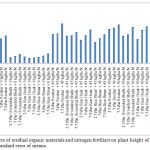 |
Figure 1: Effects of residual organic materials and nitrogen fertilizer on plant height of maize. Bars represent standard error of means. |
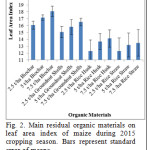 |
Figure 2: Main effect of organic materials on leaf area index of maize during 2015 cropping season. Bars represent standard error of means. |
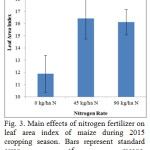 |
Figure 3: Main effects of nitrogen fertilizer on leaf area index of maize during 2015 cropping season. Bars represent standard error of means. |
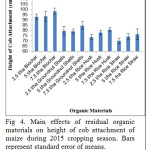 |
Figure 4: Main effects of residual organic materials on height of cob attachment of maize during 2015 cropping season. Bars represent standard error of means. |
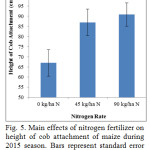 |
Figure 5: Main effects of nitrogen fertilizer on height of cob attachment of maize during 2015 season. Bars represent standard error of means. |
The enhancement of vegetative growth by organic matter residues with and without inorganic fertilizer has been previously reported.17 similarly,18 observed optimum crop growth with higher of crop residues and nitrogen rate.19 also noted organic manure in combination with inorganic fertilizer ensured increment in plant growth. Literature on growth in plant height, leaf area index and height of cob attachment by20 showed increment with integration of residual organic sources and inorganic fertilizers. In the same vein,21 reported that organic amended soils resulted in better crop establishment and positively increased crop growth rate as observed with 7.5t t/ha biochar on LAI. Sadeghi and Bahrani (2009) observed that optimum crop growth and the highest wheat grain yield was achieved with nitrogen rates, indicating that the most reliable system for dryland wheat production is the application of 70 kg/ha N. They showed that the optimum crop growth can also be achieved with the highest crop residues, indicating that the most reliable system for dryland wheat production is complete residue incorporation into the soil. These results may be due to the role of nitrogen on synthesis of chlorophyll, enzymes and proteins which in turn increases the vegetative growth.22
Reproductive characters
Days to 50% flowering
Residual organic materials supplemented with nitrogen enhanced early flowering in maize with 2.5 t/ha biochar + 90 kg N/ha, 5 t/ha biochar + 45 kg N/ha, 7 5 t/ha biochar 90 kg N/ha, 2.5 t/ha groundnut shell 90 kg N/ha and 7.5 t/ha rice straw + 45 kg N/ha taken the shortest days of 47 to 50 days to 50% flowering (Fig. 6). Timely availability of nutrients mainly nitrogen from the residual organic source with nitrogen enhanced faster crop establishment might have positively supported the physiological functions of the crop to early flowering as reported by.17
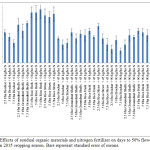 |
Figure 6: Effects of residual organic materials and nitrogen fertilizer on days to 50% flowering of maize in 2015 cropping season. Bars represent standard error of means. |
Cob Length
The result showed that main residual organic materials (p<0.001) and nitrogen amended treatments significantly (p<0.01) increased cob length at harvest. The outstanding residual organic materials were 2.5 – 7.5 t/ha biochar and 5 t/ha groundnut shell which gave a range of cob length of 15.6 to 16.5 cm (Fig. 7). N applied at 45 – 90 kg N/ha produced similar longest cob length of 15.5 to 17 cm (Fig. 8). Observed lengthy cobs in either organic amended or N plots could be attributed to high growth rate due to timely availability of adequate nutrients from both sources of soil fertility amendments which increased the dry matter accumulation and better crop growth. This result is in conformity with23 who observed lengthy cobs with the application of sole biochar.
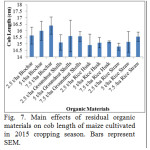 |
Figure 7: Main effects of residual organic materials on cob length of maize cultivated in 2015 cropping season. Bars represent SEM. |
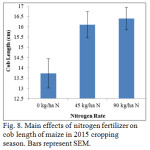 |
Figure 8: Main effects of nitrogen fertilizer on cob length of maize in 2015 cropping season. Bars represent SEM
|
Cob Weight
Cob weight as influenced by residual organic materials was in the range of 125 to 165 g/cob with 7.5 t/ha biochar supporting the highest weight, although similar results were obtained with 5 t/ha biochar, 5 – 7.5 t/ha groundnut shell and 7.5 t/ha rice straw with rice husk producing the lowest (Fig. 9). Nitrogen application increased cob weight in the range of 90 to 185 g/cob maximised at 90 kg N/ha but similar to effects of 45 kg/ha (Fig. 10). The maximum cob weight observed with residual organic matter on maize plants could be attributed to improved nitrogen uptake by the crop through enhanced organic matter decomposition and mineralization processes and indirectly from improved maize root development. Beneficial effects of organic amendments and N on improvement of soil physico-chemical properties and soil micro-organisms is well known and documented.24
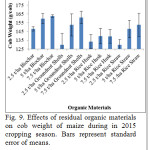 |
Figure 9: Effects of residual organic materials on cob weight of maize during in 2015 cropping season. Bars represent standard error of means. |
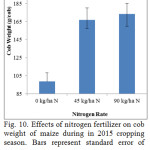 |
Figure 10: Effects of nitrogen fertilizer on cob weight of maize during in 2015 cropping season. Bars represent standard error of means. |
Grain Yield
Integration of residual organic material and nitrogen significantly (p<0.05) increased grain yield of maize with 7.5 t/ha biochar + 90 kg N/ha, 5 t/ha groundnut shell + 45 kg N/ha, 7.5 t/ha groundnut shell + 90 kg N/ha and 7.5 t/ha rice husk + 90 kg N/ha resulting in higher yields in the range of 3000 – 3600 kg/ha (Fig. 11). Residual organic materials and N effects on soil physico-chemical properties such as enhancement of water holding capacity, cation exchange capacity might have provided a medium of adequate fertility for adsorption of crop nutrients and improved conditions for soil micro-organisms as noted by.25 Organic manure efficiently adsorbs ammonia (NH3)26 and acts as a binder for ammonia in soil, therefore having the potential to decrease ammonia volatilization from soil surfaces.27 reported that timely availability of nitrogen increased maize productivity through the increased use of mineral nitrogen and organic manures. Similarly 28 and 29 reported 35% increment in grain yield through integrated organic manure and nitrogen soil fertility management.
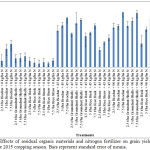 |
Figure 11: Effects of residual organic materials and nitrogen fertilizer on grain yield of maize during the 2015 cropping season. Bars represent standard error of means. |
100 Seed Weight
Hundred seed weight varied due to the effects of residual organic materials (p<0.001) and mineral nitrogen (p<0.05), with application of 7.5 t/ha biochar supporting the largest grain size of 25.5g but 5 t/ha of biochar and 7.5 t/ha groundnut shell could produce similar seed size (Fig. 12). Whilst 90 kg N/ha optimised seed weight, 45 kg N/ha gave similar size (Fig. 13).17 observed that lower nitrogen level in the soil resulted in lighter seeds.
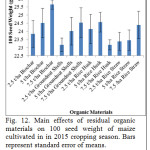 |
Figure 12: Main effects of residual organic materials on 100 seed weight of maize cultivated in in 2015 cropping season. Bars represent standard error of means. |
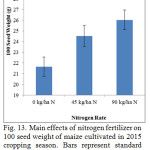 |
Figure 13: Main effects of nitrogen fertilizer on 100 seed weight of maize cultivated in 2015 cropping season. Bars represent standard error of means. |
Stover Weight
Stover weight was both highly significantly determined by residual effects of organic materials and mineral nitrogen. The highest stover weight obtained with the applications of 5 t/ha – 7.5 t/ha biochar, 5 t/ha – 7.5 t/ha groundnut shell and 7.5 t/ha rice husk (Fig. 14) could be due to continuing slow release and adequate availability of crop nutrients from the residual organic sources, which were less subjected to leaching loses. Nitrogen fertilizer application at 90 kg/ha maximized stover weight of 3500 kg/ha but was similar to impact of 45 kg N/ha (Fig. 15). Organic amended plots gave good crop establishment and positively increased crop growth rate and net assimilation rate with consequential high corn productivity.21 Similarly,30 reported increment of 118% and 130% in stover weight with complete fertilizer recommendation and sole nitrogen application respectively.
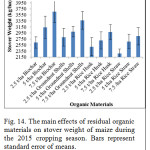 |
Figure 14: The main effects of residual organic materials on stover weight of maize during the 2015 cropping season. Bars represent standard error of means. |
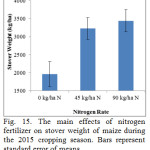 |
Figure 15: The main effects of nitrogen fertilizer on stover weight of maize during the 2015 cropping season. Bars represent standard error of means. |
Correlation Analysis
Grain yield showed strong negative correlation (-0.45, p<0.001) with days to 50% flowering but strong positive correlation with plant height at harvest, LAI, height of cob attachment, cob weight, seed weight and straw weight (Table 1).
Table 1: Pearson correlation coefficients (n=144) between grain yield and other agronomic traits of maize under residual organic matter and N fertilization in 2015 cropping season.
|
PH |
LAI at 6WAP |
LAI at 9WAP |
DFF |
HTCOB |
Cob Wt |
Seed wt |
GY |
Straw wt |
|
| PH |
1 |
||||||||
| LAI at 6WAP |
0.66** |
1 |
|||||||
| LAI at 9WAP |
0.59** |
0.59** |
1 |
||||||
| DFF |
-0.74** |
-0.57** |
-0.48** |
1 |
|||||
| HTCOB |
0.74** |
0.52** |
0.62** |
-0.58** |
1 |
||||
| COBW |
0.58** |
0.48** |
0.36** |
-0.54** |
0.60** |
1 |
|||
| Seed wt |
0.67** |
0.58** |
0.50** |
-0.55** |
0.70** |
0.67** |
1 |
||
| GY |
0.49** |
0.42** |
0.38** |
-0.45** |
0.51** |
0.43** |
0.38** |
1 |
|
| Straw wt |
0.67** |
0.60** |
0.51** |
-0.59** |
0.52** |
0.50** |
0.66** |
0.44** |
1 |
† PH = Plant height; LAI = Leaf area index; WAP = weeks after planting; DFF = days to 50% flowering; HTCOB = height of cob attachment; COBW = Cob weight and GY = grain yield; straw wt = straw weight. **- significant at (p<0.001) probability level
Regression Analysis
Controlling RS1 + Full N, the general prediction model was developed as:
Grain yield (kg/ha) = 1409 + 642 (RH3+ ½ N) + 653 (GS1+Full N) + 783 (BC3+Full N) +
168.3 (LC 9) + 16.32 (Pt ht 9) – 82.3 (50% F) [Eqn. 2]
Since the treatments were mutually exclusive, the following were the resultant models:
For RH3 + ½ N, GY = 2051 + 168.3 (LC 9) + 16.32 (Pt ht 9) – 82.3 (50% F) [Eqn. 2a]
For GS1 + Full N, GY = 2062 + 168.3 (LC 9) + 16.32 (Pt ht 9) – 82.3 (50% F) [Eqn. 2b]
For BC3 + Full N, GY = 2192 + 168.3 (LC 9) + 16.32 (Pt ht 9) – 82.3 (50% F) [Eqn. 2c]
Consequently the use of treatment RH3 + ½ N increases grain yield by 642 kg/ha over the yield that would have been obtained if RS1 + Full N were used? Also, treatment GS1 + Full N increases grain yield by 653 kg/ha over the yield that would have been obtained from RS1 + Full N [Eqn. 3b], whilst treatment BC3 + Full N increases grain yield by 783 kg/ha over the yield of RS1 + Full N [Eqn. 2c]. Evaluating the performance of each treatment in grain yield prediction indicated the treatments were best fitted in polynomials (Fig. 16a-c).
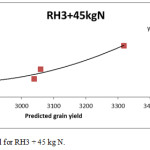 |
Figure 16 (a): The polynomial for RH3 + 45 kg N. |
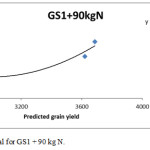 |
Figure 16 (b): The polynomial for GS1 + 90 kg N. |
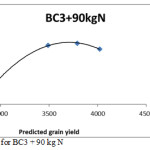 |
Figure 16 (c): The polynomial for BC3 + 90 kg N |
In conclusion, this study revealed that integrated management of one year residual effects of organic materials of biochar, groundnut shell, rice husk and rice straw with inorganic N supported increased plant height and grain yield, and moderated the time of flowering to promote production. Application of 7 5 t/ha biochar + 90 kg N/ha, 5 t/ha groundnut shell + 45 kg N/ha, 7.5 t/ha groundnut shell + 90 kg N/ha and 7.5 t/ha rice husk + 90 kg N/ha gave best options to maximise grain yield of maize within the range of 3000 – 3600 kg/ha. Correlation of grain yield with both growth and yield components showed robust relationships signifying the excellent production impact of one year residual organic materials and inorganic N on maize in the Guinea savannah.
Acknowlegdments
The authors of this Integrated Soil Fertility Management paper gratefully acknowledge the sponsorship of USAID through International Fertilizer Development Center (IFDC) ATT – Grant, Tamale Ghana Office in 2015. We also appreciate and extend our sincere thanks to the hard working staff in all departments that helped to shape this effort.
References
- Enujeke E. C., (2013). Nutrient Content (% Dry Matter) Of Maize As Affected By Different Levels Of Fertilizers In Asaba Area Of Delta State. Sustainable Agriculture Research. 2(3): 76-85
CrossRef - Dutt S. (2005). A Handbook of Agriculture. ABD Publishers, India. Pp. 116-118.
- Morris M. L., Tripp R. and Dankyi A. A. (1999). Adoption and Impacts of Improved Maize Production Technology. A Case Study of the Ghana Grains Development Project, Economics Program Paper 99-01.
- DIPA (2006). Handbook of Agriculture: Facts And Figures for Farmers, Students and All Interested In Farming. Directorate of Information and Publications of Agriculture. Indian Council of Agricultural Research, New Delhi, pp. 435.
- Buri M. M., Issaka R. N., Fujii H., and Wakatsuki T. (2010): Comparison of Soil Nutrient Status of Some Rice Growing Environments In The Major Agro-Ecological Zones of Ghana. Journal of Food, Agriculture and Environment: 8(1) 384 – 388.
- Abe S., Buri M. M., Issaka R. N., Kiepe P., and Wakatsuki T. (2010). Soil Fertility Potential for Rice Production in West African Lowlands. JARQ.44 (4): 343-355.
CrossRef - Maobe S. N., Mburu M. W. K., Akundabweni L. S. M., Ndufa J. K., Mureithi J. G., Gaehene C. K. K., Makini F. W. and Okello J. J. (2010). Residual Effect of Macuna pruriens Green Manure Application Rate on Maize (Zea mays L.) Grain Yield. World Journal of Agricultural Sciences, 6(6): 720-727.
- Sonetra S., Borin K. and Preston T. R. (2002). Waste Water from Rubber Processing as Fertilizer for Water Spinach and Forage Cassava.
- Reijnties C., Hoverkork B. and Water-Bayer A. (1992). An Introduction to Low External-Input and Sustainable Agriculture. John Wiley and Sons. London. Pp. 340.
- Adepetu, J. A. (1997). Soil and Nigeria Food Security. Inaugural Lecture Series 119, Obafemi Awolowo University, Ile-Ife, Nigeria,pp. 19.
- Nambiar K. K. M. (1991). Long Term Fertility Effects on Wheat Productivity. Wheat for the Non-Traditional Warm Area, In A Proceedings of the International Conference, Mexico.DF.CIMMYT. Pp 516-521.
- NAES (1992). Nyankpala Agricultural Experimental Station. Nyankpala, Ghana. Annual Report.
- Adu S.V. (1957). Report On The Detailed Soil Survey Of The Central Agricultural Station, Nyankpala. Soil Research Institute, Kumasi, Ghana.
- FAO/UNESCO (1997).Soil Map of the World: Revised Legend. FAO, Rome, pp. 119.
- Serno G. and Van De Weg R. F. (1985). Preliminary Assessment Of The (Available) Existing Soil Information Of Nyankpala Agricultural Experimental Station, Tamale, Northern Ghana. Stiboka, Wageningen, The Netherlands.
- Watson, D. J., 1947. Comparative physiological studies in the growth of field crops. I: Variation in net assimilation rate and leaf area between species and varieties, and within and between years. Annals of Botany: 11: 41-76.
CrossRef - Khan H. Z., Malik M. A. and Saleem M. F. (2008). Effect of Rate and Source of Organic Material on the Production Potential of Spring Maize (Zea mays L.). Pakistan Journal of Agriculture Science; 45(1): 40-43.
- Sadeghi H. and Bahrani M. J. (2009). Effects of Crop Residue a Nitrogen Rates on Yield and Yield Components of Two Dryland Wheat (Triticum aestivum L.) Cultivars. Plant Production Science, 12: 497-502.
CrossRef - Nwaiwu I. U., Ohajianya D. O., Lemchi J. I., Ibekwe U. C., Nwosu F. O., Ben-Chendo N. G., Henri-Ukoha A. and Kadiri F.A. (2010). Economics of Organic Manure Use by Food Crop Farmers in Ecologically Vulnerable Areas of Imo State, Nigeria. Researcher; 2(11): 56-61.
- Bilalis D., Efthimiadou A., Karkanis A. And Froud-Williams B. (2010). Combined Organic/Inorganic Fertilization Enhance Soil Quality and Increased Yield, Photosynthesis and Sustainability of Sweet Maize Crop. Australian Journal of Crop Science, pp. 722-729.
- Uzoma K. C., Inoue M., Andry H., Fujimaki H., Zahoor A. and Nihihara E. (2011). Effect of Cow Manure Biochar on Maize Productivity under Sandy Soil Condition. Soil Use and Management. 27: 205–212.
CrossRef - Shahin M. M., Taha S. S., Medany M. A. and Mohamed D. A. (2010). Effect of irrigation and fertilization on growth and yield of sweet pepper grown hydroponically. Bulletin of Faculty of Agriculture, Cairo University, 61(2): pp205-213.
- Arif et al, 2012
- Negassa W., Negisho K., Frison D. K., Ransom J. and Yadessa A. (2001). Determination of Optimum FYM and NP Fertilizers for Maize on Farmers’ Field. Soil Science Society Journal, 56: 476-484.
- Sohi S., Loez-Capel E., Krull E. and Bol R. (2009). Biochar’s Roles In Soil And Climate Change: A Review Of Research Needs. CSIRO Land & Water Sci. Report 05/09. 64p.
- Iyobe T., Asada T., Kawata K. and Oikawa K. (2004). Comparison of Removal Efficiencies for Ammonia and Amine Gases between Woody Charcoal and Activated Carbon. Journal of Health Science, 50: 148–153.
CrossRef - Singh B., Singh B. P. and Cowie A. L. (2010). Characterisation and Evaluation of Biochars for Their Application as a Soil Amendment. Australian Journal of Soil Research 48: 516–525.
CrossRef - Boateng S. A., Zickermann J. and Kornahreh M. (2006). Poultry Manure Effect on Growth and Yield of Maize. West Africa Journal of Applied Ecology 9: 1 – 11.
- Ali A., Arif M., Umair M., Munsif F., Ali, Inamullah K., Saleem M. and Ayub G. (2012). Effect of biochar FYM and mineral nitrogen alone and in combination on yield and yield components of maize. Sarhad J. Agric. 28(2): 191-195.
- Achieng J., Ouma G. and Odhiambo G. (2013). Use of Organic Inputs in Management of Alfisols and Ultisols for Sustainable Maize Production in Western Kenya, American Journal of Experimental Agriculture, 3(4): pp884-895
CrossRef
